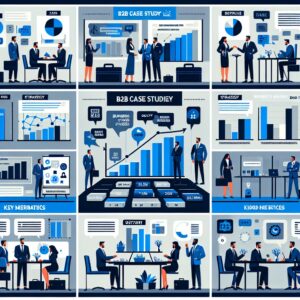Description
In the realm of business, customer success has emerged as a critical factor. It’s no longer just about making a sale.
The focus has shifted towards ensuring customers achieve their desired outcomes while using your product or service. This shift is where the concept of customer success comes into play.
But how do you measure customer success? What metrics should you track to ensure your customers are not just satisfied, but successful?
In this article, we delve into the key metrics for tracking customer success. We aim to provide you with actionable insights and best practices to enhance customer satisfaction, retention, and overall business growth.
Whether you’re a Customer Success Manager, a VP of Customer Success, or a stakeholder in a business that prioritizes customer satisfaction, this guide is for you.
Understanding Customer Success
Customer success is a proactive, real-time sales approach. It involves ensuring that your customers are continuously achieving their desired outcomes with your product or service.
It’s about understanding your customers’ needs and providing solutions that not only meet but exceed those needs. It’s about building long-term relationships with your customers, fostering loyalty, and driving repeat business.
But customer success is not just about the customer. It’s also about your business.
By ensuring customer success, you’re also ensuring your own success. Happy, successful customers are more likely to become repeat customers. They’re more likely to recommend your product or service to others.
In essence, customer success is a win-win situation. Your customers achieve their goals, and you achieve yours.
The Role of Customer Success in Business Growth
Customer success plays a pivotal role in business growth. It’s not just about retaining customers. It’s about growing with them.
When your customers succeed, they’re more likely to continue doing business with you. They’re more likely to expand their use of your product or service.
This expansion can lead to increased revenue for your business. It can also lead to new opportunities for upselling and cross-selling.
In short, customer success can drive business growth. It’s a strategy that can lead to increased customer loyalty, improved customer satisfaction, and ultimately, increased revenue.
VP Customer Success: Shaping the Strategy
The VP of Customer Success plays a crucial role in shaping the customer success strategy. They’re responsible for ensuring that the company’s customer success efforts are aligned with its overall business objectives.
They oversee the customer success team, setting goals and tracking performance. They also work closely with other departments, such as sales and marketing, to ensure a cohesive approach to customer success.
The VP of Customer Success is also responsible for identifying opportunities for improvement. They analyze customer data, identify trends, and use this information to improve the customer experience.
In essence, the VP of Customer Success is the driving force behind a company’s customer success strategy.
Lumos Customer Success Manager: Ensuring Client Satisfaction
A Lumos Customer Success Manager plays a key role in ensuring client satisfaction. They’re responsible for managing relationships with clients, understanding their needs, and ensuring that those needs are met.
They work closely with clients to understand their goals and objectives. They then work to ensure that the product or service is meeting those goals.
If issues arise, the Lumos Customer Success Manager is there to resolve them. They’re also there to identify opportunities for upselling or cross-selling.
In short, a Lumos Customer Success Manager is a client’s advocate within the company. They’re there to ensure that the client is successful, and in turn, that the company is successful.
Key Customer Success Metrics
To effectively manage customer success, it’s crucial to track the right metrics. These metrics provide insights into how well your customers are achieving their desired outcomes.
They also provide insights into how well your business is doing. By tracking customer success metrics, you can identify areas for improvement and take action to enhance customer satisfaction and retention.
Here are some key customer success metrics to consider:
- Net Promoter Score (NPS)
- Customer Health Score
- Churn Rate
- Renewal Rate
- Upsell and Cross-Sell Rates
- Customer Lifetime Value (CLV)
Each of these metrics provides a different perspective on customer success. By tracking them, you can gain a comprehensive understanding of your customers’ experiences and your business’s performance.
Net Promoter Score (NPS) and Customer Loyalty
Net Promoter Score (NPS) is a key metric for measuring customer loyalty. It’s based on one simple question: “On a scale of 0-10, how likely are you to recommend our company/product/service to a friend or colleague?”
Customers are then categorized as promoters (9-10), passives (7-8), or detractors (0-6). The NPS is calculated by subtracting the percentage of detractors from the percentage of promoters.
A high NPS indicates a high level of customer loyalty, while a low NPS suggests the opposite. By tracking NPS, you can gauge your customers’ overall sentiment towards your business and take action to improve customer loyalty.
Customer Health Score: Calculation and Interpretation
The Customer Health Score is a metric that provides a holistic view of customer health. It’s calculated based on various factors, such as product usage, customer engagement, and customer feedback.
A high Customer Health Score indicates that a customer is likely to continue doing business with you. A low score suggests that a customer may be at risk of churning.
By tracking the Customer Health Score, you can proactively manage customer relationships. You can identify at-risk customers and take action to improve their experience.
Churn Rate and Business Sustainability
Churn rate is a key metric for measuring customer retention. It’s calculated by dividing the number of customers lost during a certain period by the number of customers at the start of that period.
A high churn rate indicates a problem with customer retention. It suggests that customers are not finding value in your product or service.
By tracking churn rate, you can identify issues with customer satisfaction and take action to improve retention. This is crucial for business sustainability, as retaining existing customers is often more cost-effective than acquiring new ones.
Renewal Rate as an Indicator of Commitment
Renewal rate is another important metric for measuring customer retention. It’s calculated by dividing the number of customers who renew their contracts by the total number of customers.
A high renewal rate indicates a high level of customer commitment. It suggests that customers are finding value in your product or service and are willing to continue their relationship with your business.
By tracking renewal rate, you can gauge customer satisfaction and loyalty. You can also identify opportunities for upselling or cross-selling.
Upsell and Cross-Sell Rates: Increasing Opportunities
Upsell and cross-sell rates are key metrics for measuring customer success. Upselling involves selling a higher-end product or service to an existing customer, while cross-selling involves selling a different product or service to an existing customer.
High upsell and cross-sell rates indicate that customers are finding value in your offerings. They suggest that customers are willing to invest more in your products or services.
By tracking these rates, you can identify opportunities for revenue growth. You can also gauge customer satisfaction and loyalty.
Customer Lifetime Value (CLV) in Revenue Forecasting
Customer Lifetime Value (CLV) is a key metric for forecasting revenue. It’s calculated by multiplying the average purchase value by the average purchase frequency rate and then by the average customer lifespan.
A high CLV indicates that customers are likely to continue doing business with you over the long term. It suggests that customers are finding value in your product or service and are willing to maintain their relationship with your business.
By tracking CLV, you can forecast revenue and make informed business decisions. You can also gauge customer loyalty and identify opportunities for upselling or cross-selling.
Measuring Customer Effort and Engagement
Understanding customer effort and engagement is key to customer success. These metrics provide insights into how easy it is for customers to interact with your business and how engaged they are with your product or service.
Here are some key metrics to consider:
- Customer Effort Score (CES)
- Onboarding Effectiveness
- Product Adoption Rate
- Customer Engagement
Each of these metrics provides a different perspective on customer effort and engagement. By tracking them, you can identify areas for improvement and take action to enhance the customer experience.
Customer Effort Score (CES) and Experience Enhancement
Customer Effort Score (CES) is a metric that measures the ease of customer interactions with your business. It’s based on the question: “On a scale of 1-7, how easy was it to interact with our company?”
A high CES indicates that customers find it easy to interact with your business. A low CES suggests the opposite.
By tracking CES, you can identify areas where customer interactions can be simplified. This can lead to an enhanced customer experience and increased customer loyalty.
Onboarding Effectiveness and Product Adoption Rate
Onboarding effectiveness is a metric that measures how well new customers are onboarded. It’s calculated based on factors such as the time it takes for a new customer to start using your product or service and their level of engagement during the onboarding process.
Product adoption rate is a related metric that measures the percentage of customers who start using a new product or feature.
By tracking these metrics, you can identify areas for improvement in your onboarding process. This can lead to increased product adoption and customer satisfaction.
The Impact of Customer Engagement on Retention
Customer engagement is a key metric for measuring customer success. It’s calculated based on factors such as the frequency of customer interactions with your product or service and the depth of these interactions.
A high level of customer engagement indicates that customers are finding value in your product or service. It suggests that they are likely to continue doing business with you.
By tracking customer engagement, you can identify opportunities to enhance the customer experience. This can lead to increased customer retention and loyalty.
Leveraging Feedback and Support for Success
Customer feedback and support are crucial elements of customer success. They provide valuable insights into customer needs and expectations, helping businesses to improve their products, services, and overall customer experience.
Here are some key aspects to consider:
- Collecting and acting on customer feedback
- Responsiveness of customer support
- Building trust and loyalty through effective support
Each of these aspects plays a vital role in customer success. By leveraging them effectively, businesses can enhance customer satisfaction, retention, and loyalty.
The Value of Customer Feedback in Success Tracking
Customer feedback is a goldmine of information. It provides insights into what customers like about your product or service, what they don’t like, and what they wish you would do differently.
Collecting customer feedback is just the first step. The real value lies in acting on this feedback. This shows customers that you value their opinions and are committed to improving their experience.
By tracking customer feedback, you can identify trends and patterns. This can help you to make informed decisions about product development, customer service, and other aspects of your business.
Customer Support Responsiveness and Trust Building
The responsiveness of your customer support team can have a big impact on customer success. Customers expect quick, helpful responses to their queries and concerns. If they don’t get this, they may become frustrated and consider taking their business elsewhere.
By tracking metrics such as response time and resolution time, you can assess the effectiveness of your customer support team. This can help you to identify areas for improvement and take action to enhance the customer support experience.
Building trust and loyalty through effective customer support is crucial. When customers feel that they can rely on your support team to help them when they need it, they are more likely to remain loyal to your business.
Tools and Best Practices for Tracking Customer Success
Tracking customer success is not a one-size-fits-all process. It requires a combination of the right tools and best practices tailored to your business needs.
Here are some key considerations:
- Using software tools for analyzing customer success metrics
- Aligning metrics with business objectives
- Benchmarking against industry standards
Each of these elements plays a crucial role in effective customer success tracking. By leveraging them effectively, businesses can gain valuable insights into their customer success strategies and make informed decisions to enhance customer satisfaction and retention.
Software Tools for Analyzing Customer Success Metrics
There are numerous software tools available that can help businesses to track and analyze customer success metrics. These tools can automate the process of collecting and analyzing data, saving time and reducing the risk of errors.
Some tools offer features such as real-time analytics, predictive modeling, and customer segmentation. These can provide valuable insights into customer behavior and preferences, helping businesses to tailor their customer success strategies accordingly.
Choosing the right tool for your business depends on a variety of factors, including your specific needs, budget, and technical capabilities. It’s important to do your research and choose a tool that fits your business model and goals.
Aligning Metrics with Business Objectives and Benchmarking
Aligning customer success metrics with business objectives is crucial. This ensures that your customer success efforts are contributing to your overall business goals, such as increasing revenue, reducing churn, or improving customer satisfaction.
Benchmarking against industry standards can provide valuable insights into your performance. It can help you to identify areas where you are excelling and areas where there is room for improvement.
Remember, the goal is not just to track metrics, but to use these insights to improve your customer success strategies. By aligning your metrics with your business objectives and benchmarking against industry standards, you can ensure that your customer success efforts are driving real, measurable results.
Conclusion: The Future of Customer Success
As we move forward, customer success will continue to play a pivotal role in business growth. It’s not just about retaining customers anymore. It’s about fostering long-term relationships and turning customers into advocates for your brand.
The future of customer success lies in personalization. Businesses will need to understand their customers on a deeper level and tailor their services to meet individual needs. This will require a shift from reactive to proactive customer success strategies.
Data will continue to be at the heart of customer success. Businesses will need to leverage data analytics to understand customer behavior and preferences, and use these insights to enhance their customer success strategies.
The integration of artificial intelligence and machine learning will also play a significant role in the future of customer success. These technologies can help businesses to automate processes, predict customer behavior, and provide personalized customer experiences.
Emerging Trends and the Integration of AI in Customer Success
One of the emerging trends in customer success is the integration of artificial intelligence (AI). AI can help businesses to automate processes, predict customer behavior, and provide personalized customer experiences.
Machine learning, a subset of AI, can be used to analyze large amounts of data and identify patterns. This can provide valuable insights into customer behavior and preferences, helping businesses to tailor their customer success strategies accordingly.
Another trend is the use of predictive analytics. This involves using data to predict future customer behavior. By understanding what customers are likely to do in the future, businesses can proactively address potential issues and enhance customer satisfaction.
The use of AI and machine learning in customer success is still in its early stages. However, as these technologies continue to evolve, they will undoubtedly play an increasingly important role in customer success strategies.
In conclusion, the future of customer success is bright. With the right strategies, tools, and technologies, businesses can enhance customer satisfaction, retention, and overall business growth.
















Reviews
There are no reviews yet.